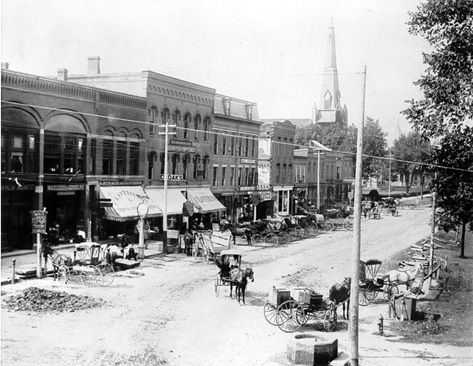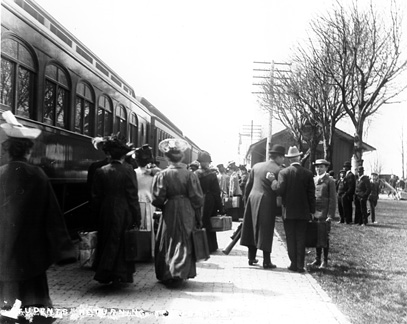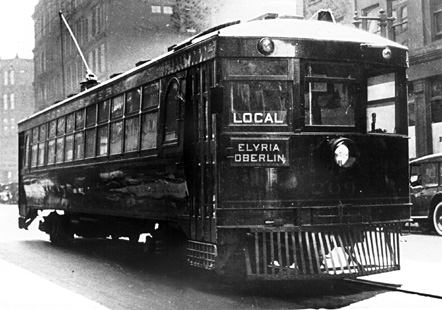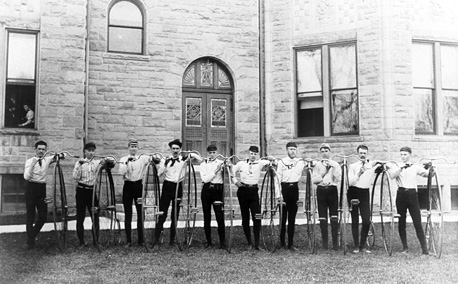Oberlin's first families heading west came from the states of Maine, Vermont, New Hampshire, Massachusetts, Connecticut, New York, and Pennsylvania. It was through wilderness that families struggled with their horses and wagons, their ox-carts, and mule teams to reach places like Oberlin.
In 1825 a new road was opened. It was a water road called the Erie Canal. While others were crossing the mountains and rivers in wagons or on horseback, people near the canal could load supplies onto a barge and, in less than a week, travel from Albany on the Hudson River to Buffalo on Lake Erie. It was much easier to move grain and machinery on boats than to travel on land.
The canal was dug by men, not machinery. It was about 320 miles long, 40 feet wide, and about four feet deep. It took eight years to build the canal. People rode on the canal in barges that were pulled by mules or teams of horses that walked on tow paths beside the canal. Along the canal travelers could spend the night and find food.
Travelers had to cross land on a wagon or cross the lake on boat to get to Oberlin from Buffalo where the Erie Canal ended. Small sailing ships, larger sailing ships called schooners, and paddle wheel steamers carried people to towns along the lake in the 1830s. Steamers sailed the 196 miles in as few as nine hours from Buffalo to Cleveland.
At first these steamers were side-wheelers with big boilers and fire boxes below decks. The wheel took up much space. It turned and dug into the water to move the boat. One of Oberlin's first students who became the college president was James Fairchild. He was only one year old in 1818 when his family crossed the lake on the first steamer to leave Buffalo. That ship was called, "Walk-in-the-Water".
Cities around the lake shore began building steamers. They cleared harbors and built lighthouses for these ships. By the year 1836, there were 45 paddle-wheelers on the lake. Some of these ships may have carried slaves to safety in Canada.
Families taking a steamer would still have to ride a stage coach to reach Oberlin. The stage coaches traveled night and day. The teams of horses galloped along the roads as quickly as they could between stopping places.
The first coaches were not comfortable. Most were canvas-covered farm wagons with benches for seats. Many of the roads were so bad that the coaches could tip over and dump the passengers to the ground. They had to worry about the muddy roads, flooding, and wild animals.
 Four-wheeled
wagons pulled by horses or oxen were the primary means for
transporting people and things from place to place. Blacksmith shops
and wagon maker shops in Oberlin were very important to build and
repair wagons. A good strong wagon was needed by every farmer in an
around town. Oberlin also had livery stables that would care for and
lend out horses.
Four-wheeled
wagons pulled by horses or oxen were the primary means for
transporting people and things from place to place. Blacksmith shops
and wagon maker shops in Oberlin were very important to build and
repair wagons. A good strong wagon was needed by every farmer in an
around town. Oberlin also had livery stables that would care for and
lend out horses.
In front of stores on College and Main Street were rails to tie horses while the people shopped or took care of business. On some tree lawns in Oberlin you can still find rings cemented to stones where horses could be tied. The heavy stone with flowers in Wright Park on Vine Street may have been filled with water for the horses.

New ideas were always being tested. Travel by rails began as early as 1800 when a small steam-powered engine first pulled a coal cart on wooden tracks. Train travel came to Oberlin in 1852 when the Toledo, Norwalk, and Cleveland Line finished laying the track that joined the older tracks to Grafton.
Railroads became very important during the Civil War. Many Oberlinians joined Abe Lincoln's Union Army. They were sent south to protect the tracks. Soldiers from the Confederacy were trying to tear up the tracks and burn them to keep the north from sending down supplies.
By 1869, people could travel from Oberlin to California or Oregon by train. Trains became the most popular means for long distance travel. Today there are only a few clues that a railroad was once here. There is the train depot building, an old caboose, and a bike path where the tracks used to be. Train travel through Oberlin ended in 1970.
 Oberlin
had another kind of rail travel in its history. In 1897 a green
trolley arrived on Main Street. The car was connected to wires
overhead. Sparks of electricity made the motors run inside the car.
The wheels were on two tracks that led to Elyria. It cost 25¢
for a round trip on this interurban car.
Oberlin
had another kind of rail travel in its history. In 1897 a green
trolley arrived on Main Street. The car was connected to wires
overhead. Sparks of electricity made the motors run inside the car.
The wheels were on two tracks that led to Elyria. It cost 25¢
for a round trip on this interurban car.
Unlike the big steam engines on the railroad, the trolley could stop anywhere quite easily. People from Oberlin could go to Cleveland to shop or to Lake Erie to swim.
But, something happened that made people stop riding the trolleys. Automobiles with gasoline-powered engines became more available. The last trolley in Oberlin was in 1931.
![]() For
all you ever wanted to know about steam locomotives, plus many
links to other railroad-related sties on the world wide web,
please visit North
American Steam Locomotives.
For
all you ever wanted to know about steam locomotives, plus many
links to other railroad-related sties on the world wide web,
please visit North
American Steam Locomotives.
In the 1890s bicycling became a popular means of travel in Oberlin. Oberlin's flat country land made it a good place for bike riding. Riders could travel on cinder roads to Elyria, to Lake Erie, or even as far as Cleveland.
Cook's Bicycle Shop on Main Street was a very important place. Cook's sold and repaired bikes. Bicycles by then had pedals, chains, and gears and were quite easy to ride. Those who wanted to have a thrill would ride the high wheelers, bikes with a big front wheel and a tiny back wheel. The pedal was attached to the hub of the front wheel so the bike had no chain. Balancing on the bike was very difficult.

The first automobiles, called "horseless carriages", were built by hand and put together piece by piece. Each car had fancy painted sides, padded seats, leather roofs, and gas lamps.
The big house on the north side of State Route 511 East, just outside of Oberlin's city limits, was the home of a pioneer in the American automobile industry. Thomas Henderson owned a bicycle shop in Cleveland with a friend named Alexander Winton. They experimented on ideas for gas engines, starters, clutches, gears, controls, and other improvements for cars. Later the business became the Winton Motor Carriage Company which began making Winton cars in 1897. Henderson talked the Goodrich Rubber Company Akron into making rubber tires for Winton cars. The first car seen in Oberlin was driven by Alexander Winton who drove one of his machines through town in 1899 on a test run from Cleveland to Chicago.
The ideas from these two men were used by another inventor, Henry Ford, when he made his first car, the Model-T. Henry Ford made cars more affordable by building them on an assembly line.
While cars were being made better, the Wright Brothers of Dayton, Ohio were trying to build a machine that would fly. They used two inventions connected to Oberlin. Aluminum, available through discoveries in Oberlin by their friend Charles Martin Hall, and rubber tires, an idea of Oberlin's Thomas Henderson.
When Oberlin was first settled, teams of horses pulled wagons four to eight miles in an hour. In 1996 Space Shuttle Endeavor, carrying astronauts on a space mission, traveled in orbit around the earth, 25,000 miles, in about 90 minutes. Who knows what transportation changes will be part of Oberlin's future?
Let Orville Wright tell you "how we made the first flight"! Also see the Wright B flyer, the first production airplane ever built.
View planes, old and new, at an airshow, click here for some more aviation links (under "top spots"), click here for some links on aviation history!
Visit the National Air and Space Museum, look under "Museum Map & Exhibits"!
The National Aeronautics and Space Administration (NASA) has a great site -- check it out! Visit the Crawford Auto-Aviation Museum site in Cleveland. This museum houses 200 antique automobiles including the first Winton to be sold.
Learn about the Winton Motor Carriage Company.
Complete the Time Line with important events in Oberlin's history related to transportation.
Write the letter of the event in the space on the time line.
______________________________________________________________________
1825*1832*1833***1852******1890s*1897*1899*****1931*****1970****1996
a. John J. Shipherd rides on horseback to Connecticut.
b. First time a car drives through Oberlin.
c. Trolley travel begins in Oberlin.
d. Trolley travel ends in Oberlin.
d. The Erie Canal, a "water road", opens.
e. Railroad travel begins in Oberlin.
f. Railroad travel ends in Oberlin.
g. Space Shuttle Endeavor carries astronauts on a space mission.
h. First college students travel to Oberlin College by stagecoach.
i. Cook's Bicycle Shop met the needs of Oberlin's early bicycle owners.
Oberlin: Yesterday, Today, Tomorrow Home
Page | Table of Contents | ![]()
![]()